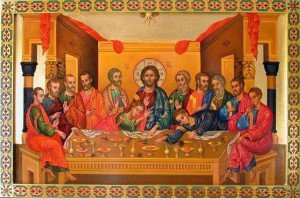Many have been the influences on the structure of the Liturgy. The Fathers of the Church, in writing about the Liturgy, also helped shape it into the experience of worship of God that we have today.
From the earliest times, the Eucharist has been a public and not a private affair, the assembly of the people of God and not the private devotion of a series of individuals. In Paul’s Letter to the Hebrews he warns Christians not to forsake coming together. Further, the Eucharist in Corinth clearly envisages a corporate act of the local church. Ignatius of Antioch similarly exhorts Christians to take carte to assemble more frequently to give thanks and praise to God.
For Ignatius, the Eucharist is a sign of the unity of the people of God. – there is one Eucharist as there is one flesh of our Lord Jesus Christ, one Church, one bishop and one altar. In the Didache, Christians pray that the bread now broken may be reassembled and reunited into one.
For Augustine, Christians are to see in the many grains, ground by prayers, moistened by the waters of baptism and united in the one Eucharistic loaf, the image of themselves as the Body of Christ, the Church.
For the Fathers, salvation lay within the Church. In fact, no sure salvation could be found outside. It is understandable, therefore, that at the heart of patristic ecclesial life should be found the solemn thanksgiving for God’s redeeming action in Christ, an action through which, moreover, the Christian community both experienced and apprehended the continuing benefits of God’s redeeming love, once and for all shown and effected in the life and passion, death and resurrection of Christ. The terms Thanksgiving (Eucharistia) and Commemoration (Anamnesis) must be examined and truly understood in the peculiar context of their times; each is closely associated with the notion of sacrifice.
Truly the Divine Liturgy involves both of these elements, that is Thanksgiving and Commemoration.
In the patristic period, Eucharistia is used to denote either the action of the presiding clergyman in reciting the prayers with themes of thanksgiving for God’s work in creation and redemption, OR for the service as a whole, OR to describe the actual consecrated gifts. We use the term Eucharist in several different ways. It is always important to distinguish the various ways in which the term is used. Justin Martyr, for example, relates that the presiding clergyman of the Eucharist gives thanks at considerable length. For Ignatius the only term he knows to describe the liturgical assembly is the eucharistia. For the Nicene Church in particular, this term, eucharistia is the usual word for the reserved Mysteries, often referred to as the eucharistized bread.

